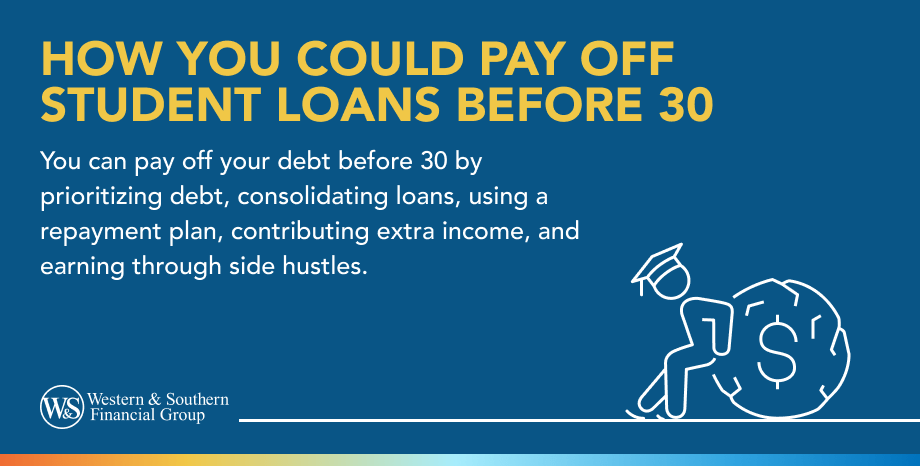

Key Takeaways
- Understand the total amount owed, interest rates, and repayment options for both federal and private loans to get a complete picture.
- Look into repayment plans like Standard, Graduated, REPAYE, and ICR options for federal loans, and consider consolidating to lower monthly payments.
- Use tax refunds, cash gifts, bonuses, or side income to make extra payments and save on interest costs.
- Find side hustles like pet sitting, surveys, ride sharing, or tutoring to earn extra income for debt repayment.
- Treat yourself after hitting repayment milestones to stay motivated through the emotional journey.
This fictional story is just one example of a student loan repayment strategy. Everyone is different and there's no one-size-fits-all approach to pay off student loans. Consider working with a financial representative to find the right strategy for you. The information in this article is intended for illustrative purposes only.
Student loan debt is an unfortunate financial reality for many young people today.
Student Loan Debt Grows
The student loan debt has risen for the past few years, and currently totaled at $1.73 trillion.1
Lauren understands this all too well. Eight years ago, Lauren graduated from college with a marketing degree and $25,000 in student loans. Starting out with very little in her early 20s — while also financially transitioning to adulthood — meant that just thinking about how to pay off student loans was a tall order.
But Lauren became laser-focused on eliminating her debt. By creating a plan and sticking to it, she paid off her loans in eight years. Today, she is proudly — and happily — debt-free.
Here's how Lauren did it before turning 30 — and how you may be able to, too.
Tallying Student Loan Debt
Lauren knew that to conquer her debt, she needed to have a more complete picture of it. This meant understanding exactly how much she owed.
She started by dividing her debts into federal and private loans. Doing this made the debt easier to understand because federal and private loans have different repayment plans.
The three major types of federal loans include the Stafford Loan, the Federal Perkins Loan and the Federal Plus Loan. While the government issues federal loans, banks, credit unions, schools and state agencies issue private loans. Lauren took note of the interest rate, compounding schedule and the total amount for each of her loans and then evaluated different repayment plans.
There are a number of repayment plans for federal loans.2 Each has certain eligibility requirements such as the type of loan you borrowed, your income and the amount of debt you have. Lauren was eligible for some of the repayment plans offered, including:
- Standard Repayment Plan: Lauren would pay a fixed amount each month for 10 years.
- Graduated Repayment Plan: Her monthly payments would start off lower, then gradually increase every few years or so. People typically pay off their loans within 10 years this way.
- Revised Pay As You Earn Repayment plan (REPAYE): With REPAYE, Lauren's monthly payments would be 10% of her income. And the payment amount would be revised each year, based on changes in her income, family size and marital status.
- Income-Contingent Repayment plan (ICR): The ICR repayment plan would include monthly payments that were less than 20% of Lauren's discretionary income, or the amount she'd pay on a plan with a fixed payment over 12 years.
These repayment plans cover federal loans. However, for private loans, repayment plans can vary by lender because different lenders offer different loans. If you have private loans, consider checking with each of your private lenders to determine the terms and conditions.
Mark milestones as you move closer to paying off loans. Get My Free Financial Review
Opting for Public Service Loan Forgiveness & Loan Consolidation
If you work for a governmental organization or nonprofit, there's also another option to repay your student loans: the Public Service Loan Forgiveness (PSLF).3 With this program, your outstanding balance is forgiven after you make 120 payments while working full-time for a qualified employer.
Because Lauren worked for a private employer, she did not qualify for the PSLF program. After carefully reviewing her options, Lauren opted for the Standard Repayment Plan, which also allowed her to make larger payments than the regular amount when she had extra income. Lauren also decided to consolidate her private loans. When she consolidated, she only had to make a single monthly payment to a single lender. Consolidation can potentially lower your monthly payments or interest rates, and paying less interest could save you money. You can consolidate your federal loans, private loans or both (Lauren consolidated her private loans).
By consolidating her private loans and using the Standard Repayment Plan for her federal loans, Lauren paid off her debt ahead of schedule. Similar to Lauren's student loan repayment strategy, the approach you choose to pay off your student loans will depend on your income, monthly budget, financial obligations and long-term goals.
Contributing Extra Money to Student Loan Debt Payments
Whenever you get a tax refund, a holiday or birthday cash gift, a bonus at work or an unexpected windfall, you may want to consider putting all or part of it toward your student loan debt.
Lauren did this by sticking to a "50/50" rule. Every time she got a tax refund or some extra cash from a birthday, she would put half of it toward her student loan debt and the other half wherever she pleased — usually in her rainy day fund and sometimes into her retirement plan.
Taking Advantage of a Side Hustle
Side hustles can be a great way to earn extra income. While working full-time, Lauren took on any side gig she could. She looked for ones that were easy — and, ideally, that she enjoyed. Pet-sitting, test proctoring and taking online surveys all helped Lauren earn extra income to reduce her student debt.
Using the same strategy may help you get rid of student loan debt faster, and in turn, save money because you pay less interest over the life of the loan.
Understanding the Emotional Journey
Paying off student loans is a tremendous task. Treating yourself for every milestone you hit can make the journey a little easier. For instance, for every $500 Lauren paid off, she treated herself to dinner at her favorite deep-dish pizzeria or taqueria. And for every $1,000 mark she hit, she bought a clothing item from a discount retailer.
Lauren realized for the first time after college that it's perfectly normal to feel emotional while you're paying off debt. After all, your financial goals can be extensions of your life goals, so your progress along one track is often connected to your growth elsewhere. When Lauren finally paid off her student loans in eight years, the feelings of joy and relief she felt were immeasurable.
It can be challenging to pay off student loans, but it can help to break the process down into more manageable pieces. By making her own debt a priority, Lauren was able to eliminate it within a reasonable time frame. Whether by earning extra income, putting cash gifts or bonuses toward your debt or cutting back on expenses to save more, it's possible that you can pay off your student loans in less time, too.
Shift your money mindset to reduce stress and grow your wealth. Get My Free Financial Review
Sources
- Total Student Loan Debt. https://educationdata.org/total-student-loan-debt.
- Repayment Plans. https://studentaid.gov/manage-loans/repayment/plans.
- Student Loan Forgiveness. https://studentaid.gov/manage-loans/forgiveness-cancellation#ways-to-qualify-for-loan-forgiveness-cancellation-or-discharge.












